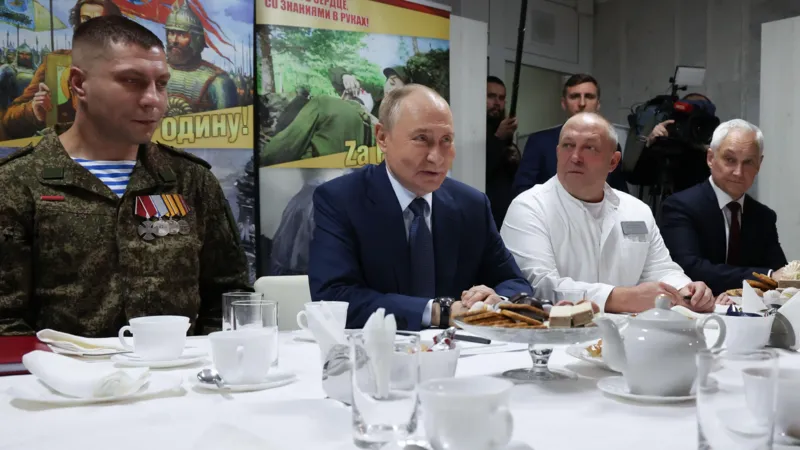President Vladimir Putin recently heralded tests of two extraordinary new Russian weapons—the Poseidon underwater drone and the Burevestnik nuclear-powered cruise missile—claiming they possess capabilities “unmatched in the world.” The Poseidon, described by a senior Russian parliamentarian as capable of “put[ting] entire states out of operation,” is a nuclear-capable, nuclear-powered underwater drone that operates like a torpedo, reportedly able to achieve speeds up to 200 km/h (120 mph) on a constantly changing, uninterceptable route.
The Burevestnik, or “unlimited-range” missile, is so novel, according to Putin, that its very class of weapons is still to be identified. While Russia’s tradition of loudly showcasing its military strength is nothing new, the timing and specific nature of these announcements have sparked intense analysis across the globe, focusing less on their immediate military utility and more on their role in the current geopolitical tension and Kremlin strategy.
The Ambiguous Military Value and Technical Hurdles
Despite the high-volume rhetoric surrounding these ‘invincible’ weapons, their actual military value remains ambiguous, particularly to observers outside of Russia. Defense analysts widely classify both the Poseidon and the Burevestnik as second-strike, retaliatory weapons. This designation implies they are weapons of Armageddon, so powerful they could not be used unless a nation was prepared to see the world destroyed, making them fundamentally deterrents rather than offensive tools. Furthermore, serious questions persist regarding the technological viability and operational reliability of both systems.
When the Burevestnik was first introduced in 2018, the International Institute of Strategic Studies (IISS), a prominent London-based think tank, noted that Russia faced “considerable technical challenges” in ensuring the reliable performance of the nuclear-propulsion unit. These concerns were tragically underscored in 2019 when five Russian nuclear engineers died in a rocket engine explosion believed by some Western experts to be linked to the Burevestnik program.
These technical setbacks and the inherently retaliatory nature of the weapons suggest the tests are primarily serving a political and psychological function rather than representing a decisive shift in conventional military power. For deeper technical analysis of these unconventional systems, the IISS website provides relevant security and conflict documentation.
Weapons as Diplomatic and Battlefield Signals
The timing of these grand-scale weapon announcements is crucial. The news came shortly after a failed diplomatic effort by the US President to mediate the war in Ukraine, culminating in the cancellation of a high-level summit between the US President and Putin and subsequent sanctions imposed on Russia’s oil industry. Facing mounting irritation from Washington over Moscow’s intractability, Putin’s decision to flaunt military superiority appears to be a calculated move to capture attention and assert that Russia still holds the “bigger cards” in the broader strategic game. Furthermore, the announcements serve as a distraction from the grinding, costly warfare currently taking place in Ukraine.
As the summer fighting season draws to a close with no clear Russian breakthrough, military intelligence experts suggest the sabre-rattling is a direct reflection of the weakness of Russia’s conventional forces. With the bulk of its army tied up in Ukraine and Moscow lacking formal security alliances that might otherwise serve as a strong deterrent, the Russian government tends to react to pressure with unnecessary and overexaggerated displays of power.
This psychological maneuvering aims to keep foreign powers, especially the US, focused on Russia’s massive nuclear capability rather than its struggles on the Ukrainian battlefield. This broader context of military alliances and deterrence strategy can be further examined through NATO’s official portal.
Geopolitical Fallout and the US Response
The Kremlin’s strategic announcements have already achieved a tangible and profound geopolitical effect. The US President immediately reacted to the Burevestnik test by instructing the US military to resume nuclear weapons testing, citing the need to keep pace with the developments of competitors like Russia and China. This decision, which marks a significant shift after a 33-year pause in US nuclear testing, suggests a direct, high-level response to the perception of Russian advancement.
While the US decision will take several months to implement and the specifics of the planned tests—likely to begin with Intercontinental Ballistic Missile (ICBM) flight tests—remain unclear, the move signifies an immediate escalation in the rhetoric of the global arms race. The Kremlin was quick to defend its actions, with spokesperson Dmitry Peskov asserting that the Russian activities “cannot in any way be interpreted as a nuclear test,” questioning the US President’s understanding of the technology.
This back-and-forth highlights the inherent difficulty in arms control and diplomacy when new nuclear-powered technologies are introduced, blurring the line between propulsion testing and weapons development. The ongoing debate over the strategic implications of resuming nuclear testing is a topic of intense study at institutions like the Arms Control Association, which monitors global nuclear policy. For information on US military capabilities and nuclear modernization efforts, relevant updates are often provided on the US Department of Defense website.



